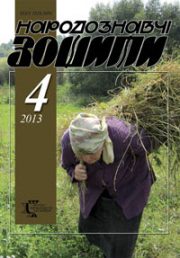The Ethnology Notebooks. 2021. № 6 (162), 1474—1482
UDK: 271.222 (470 + 571) (477.83)”1965/1991″ (045)
DOI https://doi.org/10.15407/nz2021.06.1474
STOTSKIY Yaroslav
- ORCID ID: https://orcid.org/0000-0003-0429-8740
- Professor, PhD hab. (History),
- Professor at the Department of Psychology
- Ternopil Ivan Puluj National Technical University
- Ternopil, Ukraine,
- Contacts: e-mail: jarstotskyj@ukr.net
Abstract. The article, based on archival sources, provides the study of the apogean and perigean phases of activities and status of the Russian Orthodox Church (ROC) in Lviv region in the last 26th-year-existence of the Soviet Union in the terms of political, economic and sociological analysis. Multiple methods of control and pressure from various atheistic government authorities on the service of the Orthodox clergy, the operation of Orthodox parishes and their churches are highlighted in detail. Thus, in order to limit the influence of parish priests, the regional commissioner of the Council for Religions, under the existing laws on cults, restricted the interference of the clergy in the activities of parishes, defining their functions only as liturgical duties without permission to be members of elected, executive religious G20 communities, which were not subjected to the diocesan administration.
Having taken over the parish of the Ukrainian Greek Catholic Church (UGCC) in the second half of the 1940s with the help of the communist authorities, the ROC in the Lviv region in 1965 had 692 registered communities and churches with 489 priests. For instance, on April 1, 1945, there were only 11 functioning Orthodox churches in the Lviv region, which were served by one bishop and 12 priests.
But as the economic situation of the ROC was not only stable but also growing, the number of clergy was also stable, the religiosity of the population of the region did not decrease — the state authorities intensified anti-Orthodox actions. In particular, it imposed administrative fines on priests who violated the law on cults, deregistered religious communities, closed existing churches, intensified atheistic propaganda in all spheres of society, and used dynamically inactive churches for so-called socio-cultural and economic needs (for clubs, archives, museums, libraries, warehouses for various purposes, etc.).
Keywords: priests, churches, believers, parishes, state authority, Orthodoxy, commissioner, Russian Orthodox Church.
Received 6.12.2021
REFERENCES
- Stotsky, Yaroslav. (2008). State and religions in the western regions of Ukraine: denominations, transformation in the context of state. politics of 1944—1964 years. FDA; Ltd. [in Ukrainian].
- State Archives of Lviv Region (referred to DALO). F. p. 3. Op. 9. Spr. 231 [in Ukrainian].
- (1973). Legislation on religious cults (Collection of documents and materials). Kyiv: Political Literature of Ukraine [in Ukrainian].
- DALO. F. r. 1332. Op. 1. Spr. 34 [in Ukrainian].
- DALO. F. r. 1332. Op. 1. Spr. 31[in Ukrainian].
- DALO. F. r. 1332. Op. 2. Spr. 38 [in Ukrainian].
- DALO. F p. 3. Op. 59. Spr. 196 [in Ukrainian].
- DALO. F. p. 3. Op. 59. Spr. 273 [in Ukrainian].
- (1999). History of religion in Ukraine: in 10 vol. (Vol. 3). Kyiv: Ukrainian Center for Spiritual Culture [in Ukrainian].
- Stotsky, Yaroslav. (1999). Religious situation in Ukraine: problems and trends of development (1988—1998 years). Ternopil: Aston [in Ukrainian].






